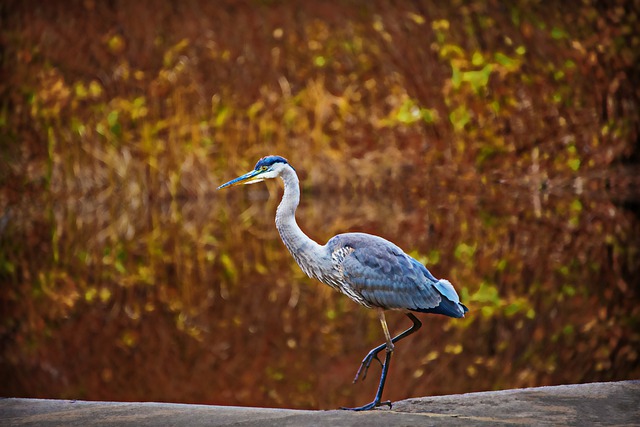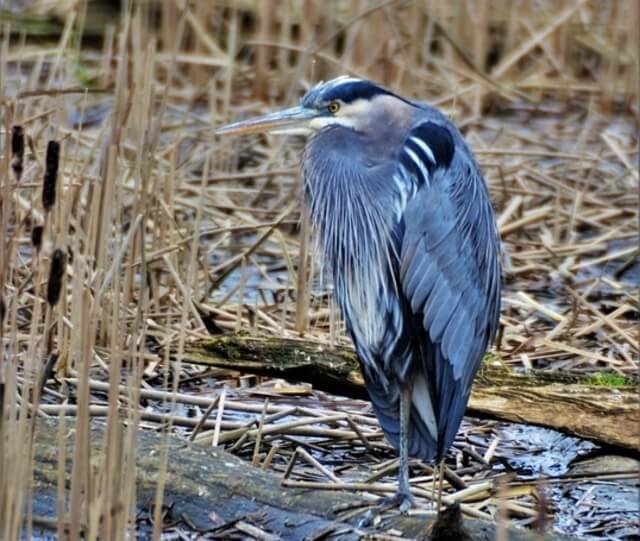If you thought you knew everything there was to know about the Great Blue Heron, think again! In this article, we’ll explore some lesser-known facts about this magnificent bird that is sure to astonish you.
Did you know, for instance, that the Great Blue Heron is one of the heaviest-flying birds in North America? Or that it has a wingspan of nearly 7 feet? Keep reading to learn more amazing facts about the Great Blue Heron!
Table of Contents
Fun Great Blue Heron Facts
- The Great Blue Heron usually feeds on smaller prey than other birds of prey, and it needs more time to catch enough food. In fact, these birds can eat up to 2 pounds of fish per day!
- They can be found living near lakes, rivers, marshes, and streams.
- These birds live in groups of 10 or more individuals with only one breeding pair at any given time.
- They stand about 3 feet tall with an average wingspan of 5.5-6.5 feet.
- They are the largest heron in North America.
- The Great Blue Heron nests on large trees near water and their eggs are very blue when they’re first laid.
- The length of their legs makes them excellent waders, but they are not very good runners, so they use trees for perching or standing on while hunting for food.
- These birds live about 15 years, and they start to mate when they are three or four years old.
- One fascinating fact about this animal is that they use their long necks to spear fish and frogs with their sharp beaks.
- The neck can even stretch up to three times its length!
Habitat
The Great Blue Heron is an incredibly large water bird in the blue heron group Ardeidae, native to the cool coastal waters and inland wetlands around the world, including North America, Galápagos, Northern Mexico, and Central America.
It’s an uncommon vagrant not only to coastal Spain in Northern Mexico and parts of South America, but also to many areas of South-Central Europe, the Bahamas, and even remote areas of far Southern Europe.
The common heron has been seen in the western Mediterranean in recent decades, so there are many locations in Europe where the common heron and the great blue herons co-exist.

Identifying
Great Blue Herons have a grayish-blue plumage on top, with white breasts and bellies. They have long, skinny necks that have a reddish hue. They have a white head with a black plume on the top, and their bill is bright yellow or orange.
Food Sources
The herons are carnivores, which means they eat meat to survive. The Great Blue Heron has long legs to wade through the water in search of prey. It has a heavy head with a sharp beak used to spear its food before swallowing it whole!
They primarily feed on fish but also eat frogs, small mammals, birds, insects, crustaceans (like crabs), reptiles (like snakes), amphibians (such as toads), and aquatic invertebrates like mollusks or shrimp.
When hunting for food, the great blue heron will stand very still with its neck extended until it catches sight of a meal.
Nesting
They usually nest in hollow tree branches, which are called crevices. They use branches as their roosting structures to protect them from predators.
These hollowed tree branches are not only for shelter but are also used for nesting. feeding their young and keeping them warm during winter.
In the springtime, the herons fly in and out of the trees to search for food. They will nest in groups, with each male and female taking a mate with them to new locations each season.
As they grow older, they will take on only one mate to nest with. These birds have no long-term relationships with other birds, instead depending only upon one mate to lay eggs.
Their reproductive output is low, with fewer offspring than the common herons, and blue herons in particular. The main purpose of blue heron nesting sites is to ensure the survival of their offspring.
The blue heron lays eggs in a hole or “basket” which contains grasses, twigs, and seeds. The blue heron will nest on top of these, and they are quite beautiful.
Many people find the sight of the blue heron nest to be one of the most amazing sights they have ever witnessed.
Migration
The Great Blue Herons migration takes place from March to May each year. During the migration, the birds fly at an altitude of about 7,000 feet above sea level.
This flight takes them from Alaska to Mexico. They usually start flying at night, so they can take advantage of tailwinds and arrive sooner.
During migration, there are many things that might distract them such as storms or other migrating birds, but with practice, they learn how to avoid these hazards. The journey for one bird is about 4000 miles long.

Predators
A blue heron that lives primarily in the Everglades, or at least near it, has no reason to be out in the ocean. There are many types of predators that threaten the Great Blue Heron, but it is not safe from any.
These birds have to be vigilant and careful with their surroundings if they want to avoid becoming prey. Their primary predators are alligators, coyotes, foxes, wolves, peregrine falcons, bald eagles, and large cats like a bobcat.
Size and Weight
The Great Blue Heron can grow up to four feet tall with a wingspan of six feet across! The average weight for this species is about 3 pounds, but males are usually heavier than females due to their larger size.
Average Lifespan
The average life span of the blue heron in the wild is between ten and seventeen years, depending on the habitat where they live.

Attracting the Blue Heron
If you want to attract these graceful birds then try some of these tips:
- Be sure your pond has a variety of fish such as bluegill, catfish, bass or crappy, and largemouth bass.
- Include a variety of bird feeders such as thistle, suet, or mealworms to attract the herons in your area. Consider adding nest boxes to keep them from being attracted elsewhere by other residents that provide these things for their feathered friends.
- Plant lots of plants such as cattails, rushes, and sedges around the edges of your pond or water feature.
- Find a place where there are tall trees and water. A tree with long branches is best for the bird to roost on at night, but any tree will work as long as it has leaves or needles. You can also create a rookery by planting trees in a small area close together near water.
Not Endangered
Although great blue herons are not really endangered, their numbers may dwindle in the coming years due to the fact that their natural habitat is being destroyed. However, the species will be protected in the future.
The United States Fish and Wildlife Service has designated the North Carolina and Georgia coastal plain as a critical habitat area that should be protected for both herons and for other sea birds.
Frequently Asked Questions
Do Great Blue Herons mate for life?
They do not typically mate for life, and they may change partners up to four times in their lifetime. However, there are many examples of birds that stay with one partner for many years.
Do Blue Herons attack humans?
It is rare for Blue Herons them to attack humans. If a blue heron does attack a person, the most likely cause would be defending its nest or young from an intruder. The bird may also try to protect itself if startled by someone too close to their nest, and will fly at the person who scared them.
What eats a Great Blue Heron?
The Great Blue Heron is a large bird that lives in North America. Their main predators include bears, raccoons, coyotes, foxes, eagles, turkey vultures, and hawks.
Are Herons smart?
Herons are very smart birds, they have been known to outsmart their predators by feeding at a distance from them. They also exhibit a high level of intelligence in hunting techniques for prey such as fish. They can also learn where their food is coming from and may even be able to plan ahead for future meals!
Can Blue Herons swim?
Yes, Blue Herons have webbed feet with claws on their toes that make them excellent swimmers. They also have hollow bones, which allows them to be lightweight and flexible enough for swimming, but strong enough for flight.
Conclusion
The great blue heron is a lovely bird and one-of-a-kind bird. It is considered to be a symbol of the beauty of nature and is a native species that is very unique.
The great blue heron is also unique because they only come out for the season. If you see them, they will be gone by the end of June, July, August, September, and October.
Related Post: 25 Birds That Eat Snakes (A Complete Guide with Photos)



